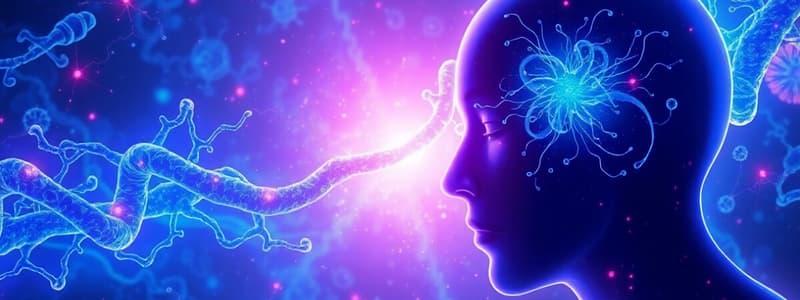Podcast
Questions and Answers
What is addiction described as, according to the case study?
What is addiction described as, according to the case study?
A complex behavior influenced by various biological factors, including brain structures, genetic predispositions, evolutionary influences, and the social functions it may serve.
What are the four different biological explanations for addiction explored in the case study?
What are the four different biological explanations for addiction explored in the case study?
- Physiological, Ontogenetic, Evolutionary, Functional (correct)
- Neurological, Cognitive, Physical, Emotional
- Psychological, Behavioral, Environmental, Social
- Genetic, Hormonal, Chemical, Physiological
What is the physiological explanation for addiction?
What is the physiological explanation for addiction?
Drug addition alters the brain's neurotransmitter functions, particularly dopamine and glutamate, disrupting mood, motivation, and cognition.
What is the ontogenetic explanation for addiction?
What is the ontogenetic explanation for addiction?
What does the evolutionary explanation for addiction suggest?
What does the evolutionary explanation for addiction suggest?
What does the functional explanation for addiction propose?
What does the functional explanation for addiction propose?
What is the key point of the physiological explanation for addiction?
What is the key point of the physiological explanation for addiction?
What is the key point of the ontogenetic explanation for addiction?
What is the key point of the ontogenetic explanation for addiction?
What is the key point of the evolutionary explanation for addiction?
What is the key point of the evolutionary explanation for addiction?
What is the key point of the functional explanation for addiction?
What is the key point of the functional explanation for addiction?
In the case study, Sarah's addiction to alcohol predates her dependence on opioids.
In the case study, Sarah's addiction to alcohol predates her dependence on opioids.
Physiological explanations center primarily on the behavior and social factors surrounding addiction.
Physiological explanations center primarily on the behavior and social factors surrounding addiction.
The ontogenetic explanation suggests that an individual's predisposition towards addiction is solely determined by their genetic makeup.
The ontogenetic explanation suggests that an individual's predisposition towards addiction is solely determined by their genetic makeup.
The evolutionary explanation argues that early humans were more likely to develop addiction due to the high potency of available psychotropic plants.
The evolutionary explanation argues that early humans were more likely to develop addiction due to the high potency of available psychotropic plants.
The functional explanation suggests that addiction can serve as a long-term solution to address underlying problems.
The functional explanation suggests that addiction can serve as a long-term solution to address underlying problems.
Flashcards
Addiction
Addiction
A complex behavior influenced by biological factors like brain structures, genetics, evolution, and social functions.
Biological Explanations of Addiction
Biological Explanations of Addiction
These explanations focus on the biological mechanisms underlying addiction, including physiological, ontogenetic, evolutionary, and functional perspectives.
Physiological Explanation
Physiological Explanation
Examines how addiction affects brain activity and organ function, particularly neurotransmitters like dopamine and glutamate.
Dopamine and Glutamate
Dopamine and Glutamate
Signup and view all the flashcards
Tolerance
Tolerance
Signup and view all the flashcards
Prefrontal Cortex
Prefrontal Cortex
Signup and view all the flashcards
Ontogenetic Explanation
Ontogenetic Explanation
Signup and view all the flashcards
Genetic Predisposition
Genetic Predisposition
Signup and view all the flashcards
Environmental Influences
Environmental Influences
Signup and view all the flashcards
Evolutionary Explanation
Evolutionary Explanation
Signup and view all the flashcards
Psychotropic Plants
Psychotropic Plants
Signup and view all the flashcards
Evolutionary Mismatch
Evolutionary Mismatch
Signup and view all the flashcards
Functional Explanation
Functional Explanation
Signup and view all the flashcards
Self-Medication
Self-Medication
Signup and view all the flashcards
Cycle of Dependence
Cycle of Dependence
Signup and view all the flashcards
Sarah's Case Study
Sarah's Case Study
Signup and view all the flashcards
Sarah's Addiction Timeline
Sarah's Addiction Timeline
Signup and view all the flashcards
Sarah's Biological Assessment
Sarah's Biological Assessment
Signup and view all the flashcards
Sarah's Family Upbringing
Sarah's Family Upbringing
Signup and view all the flashcards
Early Exposure to Alcohol
Early Exposure to Alcohol
Signup and view all the flashcards
Sarah's Peer Influence
Sarah's Peer Influence
Signup and view all the flashcards
Sarah's Substance Use History
Sarah's Substance Use History
Signup and view all the flashcards
Sarah's Relapses
Sarah's Relapses
Signup and view all the flashcards
Sarah's Current Challenges
Sarah's Current Challenges
Signup and view all the flashcards
Sarah's Future
Sarah's Future
Signup and view all the flashcards
Study Notes
Case Study Presentation - Group 5
- The presentation covers a case study on addiction, exploring different biological explanations.
- Addiction is a complex behavior influenced by biological factors such as brain structures, genetic predispositions, evolutionary influences, and social functions.
- The case study, featuring Sarah, focuses on a 32-year-old woman with a decade-long substance abuse problem.
- Sarah initially drank casually but developed a dependency on alcohol and later opioids, which has negatively impacted her family, finances, and relationships.
Different Biological Explanations
-
Physiological: Relates to the activity of the brain and other organs.
-
Drug use alters neurotransmitters (dopamine and glutamate), impacting mood, motivation, and cognition, and creates a tolerance, needing higher substance consumption to achieve the same effect.
-
This impairment of the prefrontal cortex, responsible for impulse control and decision-making, leads to struggles managing cravings and behavior.
-
Ontogenetic: Focuses on the influence of genes, nutrition, experience, and their interactions in the development of structure or behavior.
-
Sarah's addiction might be attributed to a combination of genetic predisposition and environmental influences.
-
Early exposure to alcohol and peer pressure, poor family guidance, and potentially irresponsible behaviors in her life.
-
Evolutionary: Examines the evolutionary history of a structure or behavior.
-
Psychotropic plants, used for survival by early humans, now are associated with addiction due to the potency exceeding the body's evolutionary adaptations.
-
Ancient plants had lower potency and were different from today's potent drugs, making humans more susceptible.
-
Functional: Describes why a structure or behavior evolved as it did.
-
Substance use can be a coping mechanism for difficult emotions, social pressures, or personal challenges, especially in Sarah's case, with early-adulthood stress.
-
Peer influence and self-medication can reinforce and perpetuate the cycle of dependence, while hindering efforts to address underlying struggles.
Key Points
- Drug use alters neurotransmitter functions, resulting in disruptions of mood, motivation, and cognition.
- Addiction cycles include tolerance, cravings, and impaired self-control.
- Prefrontal cortex impairment weakens impulse control and decision-making.
- Genetic factors and negative life experiences can contribute to addictive behaviors, and environmental influences might increase the risk.
- The natural potency of ancient plants was considerably lower than that of modern drugs.
- Substance use, as a coping mechanism, can exacerbate problems, rather than resolve them.
References (Note: This section contains information that's not presented in summary form in the images)
- Several academic sources are present in the slide provided. These include studies on topics relating to addiction, the brain, and neurobiology.
Studying That Suits You
Use AI to generate personalized quizzes and flashcards to suit your learning preferences.




